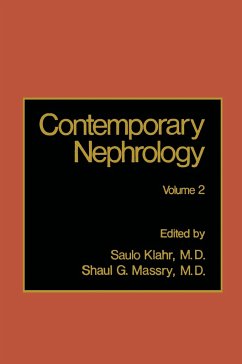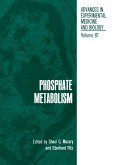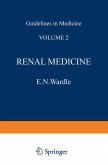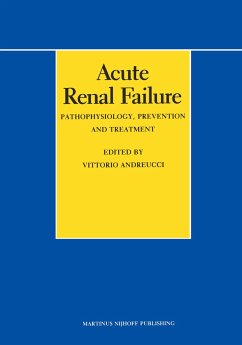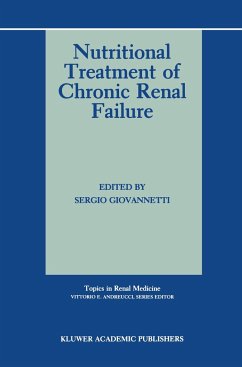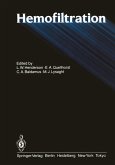Contemporary Nephrology
Volume 2
Herausgegeben:Klahr, Saulo
Contemporary Nephrology
Volume 2
Herausgegeben:Klahr, Saulo
- Broschiertes Buch
- Merkliste
- Auf die Merkliste
- Bewerten Bewerten
- Teilen
- Produkt teilen
- Produkterinnerung
- Produkterinnerung
Volume 2 of Contnnporary Xephrology updates the major developments which ha'e occurred during the past 2 years in 15 major areas of both basic and clinical nephrology. In addition, this volume has a section, Chapter 8, uitten by Drs. Pederson, Llach, and Papper, from the Med ical School at the Universitv of Oklahoma, which reviews the recent developments on nonilwasive diagnostic techniques in nephrology. The other chapters are presented in such a way as to emphasize the major advances that have occurred in the different areas in the last 2 years. In Chapter 1, Dr. Schafer analyzes in detail…mehr
Andere Kunden interessierten sich auch für
![Phosphate Metabolism Phosphate Metabolism]() Phosphate Metabolism42,99 €
Phosphate Metabolism42,99 €![Renal Medicine Renal Medicine]() E. N. WardleRenal Medicine41,99 €
E. N. WardleRenal Medicine41,99 €![Acute Renal Failure Acute Renal Failure]() Acute Renal Failure41,99 €
Acute Renal Failure41,99 €![Nutritional Treatment of Chronic Renal Failure Nutritional Treatment of Chronic Renal Failure]() Nutritional Treatment of Chronic Renal Failure242,99 €
Nutritional Treatment of Chronic Renal Failure242,99 €![Nutritional Treatment of Chronic Renal Failure Nutritional Treatment of Chronic Renal Failure]() Sergio Giovannetti (Hrsg.)Nutritional Treatment of Chronic Renal Failure242,99 €
Sergio Giovannetti (Hrsg.)Nutritional Treatment of Chronic Renal Failure242,99 €![Hemofiltration Hemofiltration]() Hemofiltration41,99 €
Hemofiltration41,99 €![Short Dialysis Short Dialysis]() Short Dialysis161,99 €
Short Dialysis161,99 €-
-
-
Volume 2 of Contnnporary Xephrology updates the major developments which ha'e occurred during the past 2 years in 15 major areas of both basic and clinical nephrology. In addition, this volume has a section, Chapter 8, uitten by Drs. Pederson, Llach, and Papper, from the Med ical School at the Universitv of Oklahoma, which reviews the recent developments on nonilwasive diagnostic techniques in nephrology. The other chapters are presented in such a way as to emphasize the major advances that have occurred in the different areas in the last 2 years. In Chapter 1, Dr. Schafer analyzes in detail the new information available regarding the action of aldosterone both in anuran membranes and in the mammalian kidney. Drs. Knox and Romero, in Chapter 2, update the information accrued du ring the last 2 years in the area of renal hemodynamics and sodium chloride excretion. In the area of renal me tabolism (Chapter 3), Schoolwerth, Little, and Idell-Wenger review in detail the metabolism oflipids in the kidney and its potential relation to renal function. This is, to the best of our knowledge, the first compre hensive review of this subject in any textbook of nephrology. Dr. Dunn provides an authoritative review of the major advances in the rapidly expanding field of prostaglandins with particular emphasis on renal prostaglandins (Chapter 4). Drs. Batlle and Kurtzman update new con cepts of acid-base phvsiology and pathophysiology, and Dr.
Hinweis: Dieser Artikel kann nur an eine deutsche Lieferadresse ausgeliefert werden.
Hinweis: Dieser Artikel kann nur an eine deutsche Lieferadresse ausgeliefert werden.
Produktdetails
- Produktdetails
- Verlag: Springer / Springer US / Springer, Berlin
- Artikelnr. des Verlages: 978-1-4615-6724-0
- Softcover reprint of the original 1st ed. 1983
- Seitenzahl: 824
- Erscheinungstermin: 12. Oktober 2012
- Englisch
- Abmessung: 229mm x 152mm x 44mm
- Gewicht: 1185g
- ISBN-13: 9781461567240
- ISBN-10: 1461567246
- Artikelnr.: 39619712
- Herstellerkennzeichnung Die Herstellerinformationen sind derzeit nicht verfügbar.
- Verlag: Springer / Springer US / Springer, Berlin
- Artikelnr. des Verlages: 978-1-4615-6724-0
- Softcover reprint of the original 1st ed. 1983
- Seitenzahl: 824
- Erscheinungstermin: 12. Oktober 2012
- Englisch
- Abmessung: 229mm x 152mm x 44mm
- Gewicht: 1185g
- ISBN-13: 9781461567240
- ISBN-10: 1461567246
- Artikelnr.: 39619712
- Herstellerkennzeichnung Die Herstellerinformationen sind derzeit nicht verfügbar.
1 Membrane Transport: Ion Transport in the Kidney and Anuran Epithelia-Mechanisms of Aldosterone Action.- 1. Introduction.- 2. The General Effects of Aldosterone.- 2.1. General Effects of Aldosterone in Anuran Epithelia.- 2.2. General Effects of Aldosterone in the Nephron.- 2.3. General Effects of Aldosterone on Other Mammalian Epithelia.- 3. Mechanisms for the Regulation of Epithelial Ion Transport.- 3.1. The Transport of Sodium Ions.- 3.2. The Transport of Potassium Ions.- 3.3. Proton Transport.- 4. Advances in Explaining the Mechanism of Aldosterone Action.- 4.1. Effect of Aldosterone on Metabolism.- 4.2. Effect of Aldosterone on Na, K-ATPase.- 4.3. Effects of Aldosterone on Ionic Conductances.- 4.4. Effects of Aldosterone on the Synthesis of Specific Proteins.- 4.5. Effects of Aldosterone on Plasma Membranes and Lipid Metabolism.- 5. Summary.- References.- 2 Renal Hemodynamics and Sodium Chloride Excretion.- 1. Autoregulation of Renal Blood Flow and Glomerular Filtration Rate.- 2. Factors That Influence Renal Hemodynamics.- 2.1. Neural Control.- 2.2. Vasoactive Agents.- 3. Sodium Excretion.- 3.1. Aldosterone in the Regulation of Sodium Excretion.- 3.2. Neural Reflex Control of Sodium Excretion.- 3.3. Intrarenal Hormone Action on Sodium Excretion.- 3.4. Physical Factors in the Regulation of Sodium Excretion.- 4. Chloride Transport.- References.- 3 Renal Metabolism.- 1. Introduction.- 2. Methodological Considerations.- 2.1. The Isolated Perfused Rat Kidney.- 2.2. Isolated Renal Tubules from Proximal and Distal Segments.- 2.3. Brush Border and Basolateral Membrane Preparations.- 2.4. Renal Cell Culture Techniques.- 2.5. Nuclear Magnetic Resonance (NMR).- 3. Biochemistry of Tubular Transport.- 3.1. Mechanisms of Transport.- 3.2. Relationships to Oxidative Metabolism.-4. Selected Aspects of Intermediary Metabolism.- 4.1. Role of Calcium and Calcium Transport.- 4.2. H+ and Intracellular pH.- 4.3. Gluconeogenesis.- 5. Coupling of Active Ion Transport and Aerobic Metabolism.- 6. Renal Lipid Metabolism.- 6.1. Fatty Acid Metabolism.- 6.2. Triacylglycerol (TG).- 6.3. Complex Lipids.- 6.4. Cholesterol.- 7. Hormones and the Kidney.- 7.1. Sites of Action along the Nephron.- 7.2. Steroid Hormones.- 7.3. Mechanism of Action-Aldosterone.- References.- 4 Renal Prostaglandins.- 1. Biochemistry of Renal Prostaglandins.- 1.1. Localization of Prostaglandin Synthesis.- 1.2. The Lipoxygenase Pathway.- 1.3. Renal Phospholipase.- 1.4. Prostaglandin Degradation.- 2. The Role of Prostaglandins in the Control of Renal Blood Flow and Glomerular Filtration Rate.- 2.1. Renal Prostaglandins and the Control of Renal Blood Flow and Glomerular Filtration Rate in the Rat.- 2.2. The Importance of Renal Prostaglandins in the Control of Renal Blood Flow during Sodium Depletion.- 2.3. Prostaglandins as Regulators of Renal Blood Flow after Reduction of Cardiac Output or in Hepatic Disease.- 2.4. Cyclooxygenase Inhibitors in the Presence of Renal Insufficiency.- 2.5. Summary.- 3. The Interrelations between Antidiuretic Hormone and Prostaglandins.- 3.1. Introduction.- 3.2. The Physiologic Interactions of Antidiuretic Hormone and Prostaglandins.- 3.3. Vasopressin and Renal Prostaglandin Synthesis.- 3.4. Effects of Prostaglandins on Urea Permeability.- 3.5. The Possible Interactions of Prostaglandins with Vasopressin-Stimulated Adenylate Cyclase and Intracellular Cyclic AMP.- 3.6. Polyurie States, Diseases of Urinary Concentrating Mechanisms and the Role of Prostaglandins.- 4. Renal Prostaglandin Synthesis and Sodium Excretion.- 4.1. Introduction.- 4.2. Sodium Intake asa Determinant of Prostaglandin Excretion.- 4.3. Cyclooxygenase Inhibition and Na Excretion.- 4.4. Cyclooxygenase Inhibitors and Diuretics.- 5. Prostaglandins and Renin Secretion by the Kidney.- 5.1. In Vitro Studies of Prostaglandins and Renin.- 5.2. In Vivo Studies of Prostaglandin Infusion and Renin Release.- 5.3. The Effect of Cyclooxygenase Inhibitors on Renin Secretion in Vivo.- 5.4. Prostaglandins, Renin, Potassium, and Bartter's Syndrome.- 6. Renal Prostaglandins and Thromboxane: A Possible Role in Hypertension.- 6.1. Renal Prostaglandin and Thromboxane Synthesis in Experimental and Human Hypertension.- 6.2. The Effects of Cyclooxygenase Inhibitors on Blood Pressure.- 7. The Role of Prostaglandins and Thromboxane in the Renal Response to Diverse Injuries.- 7.1. Ureteral Obstruction.- 7.2. The Role of Thromboxane in the Potassium-Depleted Rat Kidney and in Acute Renal Failure.- 7.3. Platelet Thromboxane and Vascular Prostacyclin in Renal Failure.- 7.4. Interactions of the Renal Kallikrein-Kinin System with Prostaglandins.- References.- 5 Acid-Base Physiology and Pathophysiology.- 1. Bicarbonate Reabsorption and Its Regulation.- 1.1. Mechanism.- 1.2. Factors That Regulate Bicarbonate Reabsorption.- 2. Acid Excretion and Its Regulation.- 2.1. Ammonia Production and Ammonium Excretion.- 2.2. Role of Aldosterone and Potassium.- 2.3. Role of Other Steroid Hormones.- 2.4. Role of Distal Sodium Delivery and Transport.- 3. Urinary PCO2 as an Index of Distal Acidification.- 3.1. Urinary PCO2 during Sodium Bicarbonate Loading.- 3.2. Urine PCO2 during Neutral Sodium Phosphate Infusion.- 4. Acidification by Epithelial Membranes Analogous to the Mammalian Collecting Duct.- 4.1. Nature of the Proton Pump.- 4.2. Factors That Regulate Proton Secretion.- 5. Role of ParathyroidHormone, Calcium, and Vitamin D on Acid-Base Homeostasis.- 6. Clinical Syndromes.- 6.1. Current Concepts of the Pathogenesis of Distal Renal Tubular Acidosis (DRTA).- 6.2. "Secretory" DRTA.- 6.3. "Back-Leak" DRTA.- 6.4. Distal RTA with Intact Capacity to Lower Urinary pH (Rate-Dependent DRTA).- 6.5. Hyperkalemic DRTA.- 6.6. Selective Aldosterone Deficiency (SAD) ("Type IV RTA").- 6.7. Aldosterone Resistance.- 7. Diagnosis and Treatment.- References.- 6 Mineral Metabolism in Health and Disease.- 1. Parathyroid Hormone.- 1.1. Biosynthesis of PTH.- 1.2. Regulation of PTH Secretion.- 1.3. Regulation of PTH Secretion in Hyperparathyroidism.- 1.4. Metabolism of PTH.- 1.5. Pitfalls in the Interpretation of the Immunoassay for PTH.- 1.6. Parathyroid Hormone: Renal Effects.- 1.7. PTH as a Uremic Toxin.- 2. Calcium and Magnesium: Physiology and Pathophysiology.- 2.1. Renal Handling of Magnesium.- 2.2. Renal Handling of Calcium.- 2.3. Hypercalcemia.- 2.4. Hypocalcemia.- 3. Phosphate Physiology and Pathophysiology.- 3.1. Gastrointestinal Absorption.- 3.2. Renal Handling of Phosphate.- 3.3. Hypophosphatemia.- 3.4. Hyperphosphatemia.- 4. Renal Osteodystrophy.- 4.1. Pathogenesis.- 4.2. Diagnosis.- 4.3. Therapy.- References.- 7 Renal Vascular Hypertension.- 1. Introduction.- 2. Incidence.- 3. Pathophysiology.- 4. Clinical Expression.- 5. Diagnostic Considerations.- 5.1. Intravenous Pyelography.- 5.2. Radioisotope Renography.- 5.3. Digital Subtraction Angiography.- 5.4. Plasma Renin Activity.- 5.5. Angiotensin Competitive Antagonists.- 6. Results of Surgery.- 7. Percutaneous Transluminal Angioplasty.- 8. Medical Therapy in Renovascular Hypertension.- 9. Renal Function: The Effect of Therapy.- 10. Conclusion.- References.- 8 Noninvasive Diagnostic Techniques in Nephrology:Recent Developments.- 1. Introduction.- 2. Microscopic Examination and Dip Tests of the Urine.- 2.1. Leukocyte Esterase Dip Test.- 2.2. Hematuria.- 2.3. Fluorescent-Y-Body Urine Cytology.- 3. Urine Indices and Excretion Products.- 3.1. Fractional Electrolyte Excretion.- 3.2. Renal Tubular Antigen.- 3.3. ?-2-Microglobulin.- 3.4. Urine Immunoreactive Thromboxane B2.- 4. Radioisotope Techniques.- 4.1. Renography.- 4.2. Renal Function Studies.- 4.3. Isotope Imaging.- 5. Sonography.- 5.1. Renal Size and Obstructive Uropathy.- 5.2. In Utero Renal Abnormalities.- 5.3. Renal and Juxtarenal Masses.- 5.4. Renal Vascular Problems.- 5.5. Other Renal Pathology.- 6. Radiography.- 7. Computed Tomography.- 7.1. Tumors and Masses.- 7.2. Renal Trauma.- 7.3. Renal Dysfunction.- 7.4. Renal Vascular Disorders.- 7.5. Dynamic Data.- 8. Digital Subtraction Angiography.- 9. Nuclear Magnetic Resonance.- References.- 9 Immunological Aspects of Renal Disease.- 1. Introduction.- 2. Immune-Complex-Mediated Glomerulonephritis.- 2.1. Basic Investigations.- 2.2. Autologous Immune Complex Glomerulonephritis.- 2.3. Murine Systemic Lupus Erythematosus.- 2.4. Circulating Immune Complexes.- 3. Complement and Renal Diseases.- 4. Coagulation in Renal Disease.- 5. Cell-Mediated Immunity in Renal Disease.- 6. Mechanisms of Proteinuria.- 6.1. Basic Studies.- 6.2. Clinical Aspects of Asymptomatic Proteinuria and/or Hematuria.- 7. Studies of Glomerular Structure and Function.- 7.1. Structural Studies.- 7.2. Tissue Culture.- 7.3. Fundamental Studies.- 8. Clinical Studies of Renal Disease.- 8.1. Nephrotic Syndrome.- 8.2. Multisystem and Hereditary Disease.- 8.3. Hereditary Diseases.- 8.4. Neoplasms and Glomerular Disease.- 8.5. Infection and Glomerular Disease.- 8.6. Drugs and Renal Disease.- 8.7. MiscellaneousRenal Diseases.- References.- 10 Acute Renal Failure and Toxic Nephropathy.- 1. Introduction.- 2. Pathophysiologic Considerations.- 2.1. Experimental Ischemic ARF.- 2.2. Experimental Myohemoglobinuric ARF.- 2.3. Experimental Nephrotoxic ARF.- 3. Clinical Considerations.- 3.1. Diagnosis of ARF.- 3.2. Clinical Course of ARF.- 3.3. Therapy of ARF.- 4. Summary and Conclusion.- References.- 11 The Kidney in Systemic Disease.- 1. Introduction.- 2. Changes in the Volume of Body Fluid Compartments.- 2.1. Congestive Heart Failure.- 2.2. Cirrhosis of the Liver.- 3. Alterations in the Composition of the Blood (Noxious Substances).- 3.1. Calcium.- 3.2. Rhabdomyolysis-Myoglobinuria.- 3.3. Hemolysis-Hemoglobinuria.- 3.4. Multiple Myeloma-Light Chain Nephropathy.- 4. Alteration of Endogenous Substances That May Lead to Vascular and Tubular Abnormalities.- 5. Tubular and Vascular Disruption Associated with Systemic Disease.- 5.1. Papillary Necrosis.- 5.2. Leukemias and Lymphomas.- References.- 12 Uremia.- 1. Introduction.- 2. Uremic Toxins.- 2.1. Small Molecular Weight Molecules (Mol. Wt. Less Than 300).- 2.2. Middle Molecular Weight Molecules (MM) (Mol. Wt. 200 to 500-2000 to 5000).- 2.3. Large Polypeptides.- 2.4. Problems in Identification of Uremic Toxins.- 3. Chronic Renal Failure.- 3.1. Factors Implicated in Progressive Loss of Renal Function.- 3.2. Adaptation to Nephron Loss.- 3.3. Urea Cycle in Uremia.- 3.4. Amino Acid Metabolism.- 3.5. Muscle Metabolism.- 3.6. Carbohydrate Metabolism-Hypoglycemia.- 3.7. Gastrointestinal Function-Calcium and Phosphate Absorption.- 4. Complications of Uremia.- 4.1. Hematologic.- 4.2. Endocrine.- 4.3. Neurologic.- 4.4. Immunologic.- 4.5. Cardiovascular.- 4.6. Uremic Osteodystrophy.- 4.7. Oxalate in CRF.- References.- 13 Nutrition in RenalDisease.- 1. Introduction.- 2. Nitrogen Metabolism.- 2.1. Nitrogenous Waste Products.- 2.2. Amino Acid Metabolism.- 2.3. Nitrogen-Free Analogues of Essential Amino Acids.- 2.4. The Protein Requirements of Dialysis Patients.- 3. Energy Metabolism.- 3.1. Glucose-Insulin.- 3.2. Lipids.- 4. Vitamins and Trace Metals.- 5. Acute Renal Failure.- 6. Chronic Renal Failure in Children.- 7. Progression of Renal Insufficiency.- 7.1. Introduction.- 7.2. The Course of Renal Insufficiency.- 7.3. Nephrotoxicity of Excessive Dietary Protein.- 7.4. Divalent Ion Metabolism and Loss of Renal Function.- 7.5. Altered Glomerular Hemodynamics and Loss of Residual Renal Function.- 7.6. Progression of Renal Insufficiency in Humans.- References.- 14 Dialysis, Hemofiltration, and Hemoperfusion.- 1. Socioeconomic Issues.- 2. Rehabilitation.- 3. Neuropsychiatrie Aspects.- 4. Survival Rates.- 5. Perceptions by Patients.- 6. Efficiency of Dialysis-Effect on Morbidity of Uremia.- 7. Acute Complications of Hemodialysis.- 7.1. Hypotension.- 7.2. Cardiac Effects of Dialysis.- 7.3. Acetate Toxicity.- 7.4. Hypoxemia Complicating Dialysis.- 7.5. Miscellaneous Acute Complications.- 8. Chronic Complications of Dialysis.- 8.1. Trace Metal Intoxications.- 8.2. Hepatitis.- 8.3. Infection in Dialysis Patients.- 8.4. Carcinogenesis and Dialysis.- 8.5. Heart Disease, Lipids, and Dialysis.- 8.6. Effects of Dialysis on Nutrition.- 8.7. Effects of Dialysis on Calcium Metabolism and Osteodystrophy.- 8.8. Miscellaneous Chronic Complications of Dialysis.- 9. Improvements in Dialysis Technology.- 9.1. Hemoperfusion.- 9.2. Reuse of Dialyzers.- 9.3. Hemofiltration.- 9.4. Hazards of New Treatments.- 10. Peritoneal Dialysis.- 10.1. Advantages and Disadvantages of Peritoneal Dialysis.- 10.2. Physiology of the Peritoneum.- 10.3. Clinical Results of Peritoneal Dialysis.- 10.4. Peritonitis.- 11. Interactions of Dialysis with Drugs and Poisons.- 12. Unusual Indications for Dialysis.- 13. Concluding Commentary.- References.- 15 Renal Transplantation.- 1. Introduction.- 2. Cyclosporine.- 2.1. Cyclosporine and Interleukin-2.- 2.2. Cyclosporine and Concanavalin A.- 2.3. Side Effects of Cyclosporine.- 3. Administration of Corticosteroids.- 4. Horse Antihuman Thymocyte Globulin Therapy.- 5. Compatible HLA Antigen Therapy.- 6. Second Renal Allografts.- 7. Renal Failure, Renal Transplant, and Pregnancy.- 8. Infection and the Transplant Recipient.- 9. Conclusions.- References.- 16 Drugs and the Kidney.- 1. Introduction.- 2. Basic Pharmacokinetics and the Effects of Renal Disease.- 2.1. Absorption of Drugs.- 2.2. Drug Distribution and Renal Disease.- 2.3. Binding of Drugs to Plasma Proteins in Renal Disease.- 2.4. Biotransformation.- 3. Drug Handling by the Kidney.- 3.1. Tubular Mechanisms of Drug Transport.- 3.2. Tubular Secretion of Drugs.- 3.3. Changes in Renal Drug Handling with Age.- 4. Clinical Use of Drugs in Renal Failure.- 4.1. Assessment of Renal Function.- 4.2. Nomograms and Dosing Strategy.- 4.3. Effects of Hemodialysis, Hemoperfusion, and Peritoneal Dialysis on Drug Pharmacokinetics.- 4.4. Drug Interactions.- 5. Aspects of Specific Drugs in Patients with Renal Disease.- 5.1. Aminoglycoside Antibiotics.- 5.2. Penicillins and Cephalosporins.- 5.3. Other Antimicrobials.- 5.4. Cardiac Glycosides and Antiarrhythmic Drugs.- 5.5. Antihypertensive Drugs Including New Beta-Blockers.- 5.6. Diuretics.- 5.7. Miscellaneous Drugs.- 6. Nephrotoxicity of Therapeutic Agents.- 6.1. Cyclosporin A.- 6.2. Lithium.- 6.3. ds-Platinum.- 6.4. Aminoglycoside Antibiotics.- 6.5. Radiologic Contrast Media.- 6.6. Miscellaneous Drugs.- References.
1 Membrane Transport: Ion Transport in the Kidney and Anuran Epithelia-Mechanisms of Aldosterone Action.- 1. Introduction.- 2. The General Effects of Aldosterone.- 2.1. General Effects of Aldosterone in Anuran Epithelia.- 2.2. General Effects of Aldosterone in the Nephron.- 2.3. General Effects of Aldosterone on Other Mammalian Epithelia.- 3. Mechanisms for the Regulation of Epithelial Ion Transport.- 3.1. The Transport of Sodium Ions.- 3.2. The Transport of Potassium Ions.- 3.3. Proton Transport.- 4. Advances in Explaining the Mechanism of Aldosterone Action.- 4.1. Effect of Aldosterone on Metabolism.- 4.2. Effect of Aldosterone on Na, K-ATPase.- 4.3. Effects of Aldosterone on Ionic Conductances.- 4.4. Effects of Aldosterone on the Synthesis of Specific Proteins.- 4.5. Effects of Aldosterone on Plasma Membranes and Lipid Metabolism.- 5. Summary.- References.- 2 Renal Hemodynamics and Sodium Chloride Excretion.- 1. Autoregulation of Renal Blood Flow and Glomerular Filtration Rate.- 2. Factors That Influence Renal Hemodynamics.- 2.1. Neural Control.- 2.2. Vasoactive Agents.- 3. Sodium Excretion.- 3.1. Aldosterone in the Regulation of Sodium Excretion.- 3.2. Neural Reflex Control of Sodium Excretion.- 3.3. Intrarenal Hormone Action on Sodium Excretion.- 3.4. Physical Factors in the Regulation of Sodium Excretion.- 4. Chloride Transport.- References.- 3 Renal Metabolism.- 1. Introduction.- 2. Methodological Considerations.- 2.1. The Isolated Perfused Rat Kidney.- 2.2. Isolated Renal Tubules from Proximal and Distal Segments.- 2.3. Brush Border and Basolateral Membrane Preparations.- 2.4. Renal Cell Culture Techniques.- 2.5. Nuclear Magnetic Resonance (NMR).- 3. Biochemistry of Tubular Transport.- 3.1. Mechanisms of Transport.- 3.2. Relationships to Oxidative Metabolism.-4. Selected Aspects of Intermediary Metabolism.- 4.1. Role of Calcium and Calcium Transport.- 4.2. H+ and Intracellular pH.- 4.3. Gluconeogenesis.- 5. Coupling of Active Ion Transport and Aerobic Metabolism.- 6. Renal Lipid Metabolism.- 6.1. Fatty Acid Metabolism.- 6.2. Triacylglycerol (TG).- 6.3. Complex Lipids.- 6.4. Cholesterol.- 7. Hormones and the Kidney.- 7.1. Sites of Action along the Nephron.- 7.2. Steroid Hormones.- 7.3. Mechanism of Action-Aldosterone.- References.- 4 Renal Prostaglandins.- 1. Biochemistry of Renal Prostaglandins.- 1.1. Localization of Prostaglandin Synthesis.- 1.2. The Lipoxygenase Pathway.- 1.3. Renal Phospholipase.- 1.4. Prostaglandin Degradation.- 2. The Role of Prostaglandins in the Control of Renal Blood Flow and Glomerular Filtration Rate.- 2.1. Renal Prostaglandins and the Control of Renal Blood Flow and Glomerular Filtration Rate in the Rat.- 2.2. The Importance of Renal Prostaglandins in the Control of Renal Blood Flow during Sodium Depletion.- 2.3. Prostaglandins as Regulators of Renal Blood Flow after Reduction of Cardiac Output or in Hepatic Disease.- 2.4. Cyclooxygenase Inhibitors in the Presence of Renal Insufficiency.- 2.5. Summary.- 3. The Interrelations between Antidiuretic Hormone and Prostaglandins.- 3.1. Introduction.- 3.2. The Physiologic Interactions of Antidiuretic Hormone and Prostaglandins.- 3.3. Vasopressin and Renal Prostaglandin Synthesis.- 3.4. Effects of Prostaglandins on Urea Permeability.- 3.5. The Possible Interactions of Prostaglandins with Vasopressin-Stimulated Adenylate Cyclase and Intracellular Cyclic AMP.- 3.6. Polyurie States, Diseases of Urinary Concentrating Mechanisms and the Role of Prostaglandins.- 4. Renal Prostaglandin Synthesis and Sodium Excretion.- 4.1. Introduction.- 4.2. Sodium Intake asa Determinant of Prostaglandin Excretion.- 4.3. Cyclooxygenase Inhibition and Na Excretion.- 4.4. Cyclooxygenase Inhibitors and Diuretics.- 5. Prostaglandins and Renin Secretion by the Kidney.- 5.1. In Vitro Studies of Prostaglandins and Renin.- 5.2. In Vivo Studies of Prostaglandin Infusion and Renin Release.- 5.3. The Effect of Cyclooxygenase Inhibitors on Renin Secretion in Vivo.- 5.4. Prostaglandins, Renin, Potassium, and Bartter's Syndrome.- 6. Renal Prostaglandins and Thromboxane: A Possible Role in Hypertension.- 6.1. Renal Prostaglandin and Thromboxane Synthesis in Experimental and Human Hypertension.- 6.2. The Effects of Cyclooxygenase Inhibitors on Blood Pressure.- 7. The Role of Prostaglandins and Thromboxane in the Renal Response to Diverse Injuries.- 7.1. Ureteral Obstruction.- 7.2. The Role of Thromboxane in the Potassium-Depleted Rat Kidney and in Acute Renal Failure.- 7.3. Platelet Thromboxane and Vascular Prostacyclin in Renal Failure.- 7.4. Interactions of the Renal Kallikrein-Kinin System with Prostaglandins.- References.- 5 Acid-Base Physiology and Pathophysiology.- 1. Bicarbonate Reabsorption and Its Regulation.- 1.1. Mechanism.- 1.2. Factors That Regulate Bicarbonate Reabsorption.- 2. Acid Excretion and Its Regulation.- 2.1. Ammonia Production and Ammonium Excretion.- 2.2. Role of Aldosterone and Potassium.- 2.3. Role of Other Steroid Hormones.- 2.4. Role of Distal Sodium Delivery and Transport.- 3. Urinary PCO2 as an Index of Distal Acidification.- 3.1. Urinary PCO2 during Sodium Bicarbonate Loading.- 3.2. Urine PCO2 during Neutral Sodium Phosphate Infusion.- 4. Acidification by Epithelial Membranes Analogous to the Mammalian Collecting Duct.- 4.1. Nature of the Proton Pump.- 4.2. Factors That Regulate Proton Secretion.- 5. Role of ParathyroidHormone, Calcium, and Vitamin D on Acid-Base Homeostasis.- 6. Clinical Syndromes.- 6.1. Current Concepts of the Pathogenesis of Distal Renal Tubular Acidosis (DRTA).- 6.2. "Secretory" DRTA.- 6.3. "Back-Leak" DRTA.- 6.4. Distal RTA with Intact Capacity to Lower Urinary pH (Rate-Dependent DRTA).- 6.5. Hyperkalemic DRTA.- 6.6. Selective Aldosterone Deficiency (SAD) ("Type IV RTA").- 6.7. Aldosterone Resistance.- 7. Diagnosis and Treatment.- References.- 6 Mineral Metabolism in Health and Disease.- 1. Parathyroid Hormone.- 1.1. Biosynthesis of PTH.- 1.2. Regulation of PTH Secretion.- 1.3. Regulation of PTH Secretion in Hyperparathyroidism.- 1.4. Metabolism of PTH.- 1.5. Pitfalls in the Interpretation of the Immunoassay for PTH.- 1.6. Parathyroid Hormone: Renal Effects.- 1.7. PTH as a Uremic Toxin.- 2. Calcium and Magnesium: Physiology and Pathophysiology.- 2.1. Renal Handling of Magnesium.- 2.2. Renal Handling of Calcium.- 2.3. Hypercalcemia.- 2.4. Hypocalcemia.- 3. Phosphate Physiology and Pathophysiology.- 3.1. Gastrointestinal Absorption.- 3.2. Renal Handling of Phosphate.- 3.3. Hypophosphatemia.- 3.4. Hyperphosphatemia.- 4. Renal Osteodystrophy.- 4.1. Pathogenesis.- 4.2. Diagnosis.- 4.3. Therapy.- References.- 7 Renal Vascular Hypertension.- 1. Introduction.- 2. Incidence.- 3. Pathophysiology.- 4. Clinical Expression.- 5. Diagnostic Considerations.- 5.1. Intravenous Pyelography.- 5.2. Radioisotope Renography.- 5.3. Digital Subtraction Angiography.- 5.4. Plasma Renin Activity.- 5.5. Angiotensin Competitive Antagonists.- 6. Results of Surgery.- 7. Percutaneous Transluminal Angioplasty.- 8. Medical Therapy in Renovascular Hypertension.- 9. Renal Function: The Effect of Therapy.- 10. Conclusion.- References.- 8 Noninvasive Diagnostic Techniques in Nephrology:Recent Developments.- 1. Introduction.- 2. Microscopic Examination and Dip Tests of the Urine.- 2.1. Leukocyte Esterase Dip Test.- 2.2. Hematuria.- 2.3. Fluorescent-Y-Body Urine Cytology.- 3. Urine Indices and Excretion Products.- 3.1. Fractional Electrolyte Excretion.- 3.2. Renal Tubular Antigen.- 3.3. ?-2-Microglobulin.- 3.4. Urine Immunoreactive Thromboxane B2.- 4. Radioisotope Techniques.- 4.1. Renography.- 4.2. Renal Function Studies.- 4.3. Isotope Imaging.- 5. Sonography.- 5.1. Renal Size and Obstructive Uropathy.- 5.2. In Utero Renal Abnormalities.- 5.3. Renal and Juxtarenal Masses.- 5.4. Renal Vascular Problems.- 5.5. Other Renal Pathology.- 6. Radiography.- 7. Computed Tomography.- 7.1. Tumors and Masses.- 7.2. Renal Trauma.- 7.3. Renal Dysfunction.- 7.4. Renal Vascular Disorders.- 7.5. Dynamic Data.- 8. Digital Subtraction Angiography.- 9. Nuclear Magnetic Resonance.- References.- 9 Immunological Aspects of Renal Disease.- 1. Introduction.- 2. Immune-Complex-Mediated Glomerulonephritis.- 2.1. Basic Investigations.- 2.2. Autologous Immune Complex Glomerulonephritis.- 2.3. Murine Systemic Lupus Erythematosus.- 2.4. Circulating Immune Complexes.- 3. Complement and Renal Diseases.- 4. Coagulation in Renal Disease.- 5. Cell-Mediated Immunity in Renal Disease.- 6. Mechanisms of Proteinuria.- 6.1. Basic Studies.- 6.2. Clinical Aspects of Asymptomatic Proteinuria and/or Hematuria.- 7. Studies of Glomerular Structure and Function.- 7.1. Structural Studies.- 7.2. Tissue Culture.- 7.3. Fundamental Studies.- 8. Clinical Studies of Renal Disease.- 8.1. Nephrotic Syndrome.- 8.2. Multisystem and Hereditary Disease.- 8.3. Hereditary Diseases.- 8.4. Neoplasms and Glomerular Disease.- 8.5. Infection and Glomerular Disease.- 8.6. Drugs and Renal Disease.- 8.7. MiscellaneousRenal Diseases.- References.- 10 Acute Renal Failure and Toxic Nephropathy.- 1. Introduction.- 2. Pathophysiologic Considerations.- 2.1. Experimental Ischemic ARF.- 2.2. Experimental Myohemoglobinuric ARF.- 2.3. Experimental Nephrotoxic ARF.- 3. Clinical Considerations.- 3.1. Diagnosis of ARF.- 3.2. Clinical Course of ARF.- 3.3. Therapy of ARF.- 4. Summary and Conclusion.- References.- 11 The Kidney in Systemic Disease.- 1. Introduction.- 2. Changes in the Volume of Body Fluid Compartments.- 2.1. Congestive Heart Failure.- 2.2. Cirrhosis of the Liver.- 3. Alterations in the Composition of the Blood (Noxious Substances).- 3.1. Calcium.- 3.2. Rhabdomyolysis-Myoglobinuria.- 3.3. Hemolysis-Hemoglobinuria.- 3.4. Multiple Myeloma-Light Chain Nephropathy.- 4. Alteration of Endogenous Substances That May Lead to Vascular and Tubular Abnormalities.- 5. Tubular and Vascular Disruption Associated with Systemic Disease.- 5.1. Papillary Necrosis.- 5.2. Leukemias and Lymphomas.- References.- 12 Uremia.- 1. Introduction.- 2. Uremic Toxins.- 2.1. Small Molecular Weight Molecules (Mol. Wt. Less Than 300).- 2.2. Middle Molecular Weight Molecules (MM) (Mol. Wt. 200 to 500-2000 to 5000).- 2.3. Large Polypeptides.- 2.4. Problems in Identification of Uremic Toxins.- 3. Chronic Renal Failure.- 3.1. Factors Implicated in Progressive Loss of Renal Function.- 3.2. Adaptation to Nephron Loss.- 3.3. Urea Cycle in Uremia.- 3.4. Amino Acid Metabolism.- 3.5. Muscle Metabolism.- 3.6. Carbohydrate Metabolism-Hypoglycemia.- 3.7. Gastrointestinal Function-Calcium and Phosphate Absorption.- 4. Complications of Uremia.- 4.1. Hematologic.- 4.2. Endocrine.- 4.3. Neurologic.- 4.4. Immunologic.- 4.5. Cardiovascular.- 4.6. Uremic Osteodystrophy.- 4.7. Oxalate in CRF.- References.- 13 Nutrition in RenalDisease.- 1. Introduction.- 2. Nitrogen Metabolism.- 2.1. Nitrogenous Waste Products.- 2.2. Amino Acid Metabolism.- 2.3. Nitrogen-Free Analogues of Essential Amino Acids.- 2.4. The Protein Requirements of Dialysis Patients.- 3. Energy Metabolism.- 3.1. Glucose-Insulin.- 3.2. Lipids.- 4. Vitamins and Trace Metals.- 5. Acute Renal Failure.- 6. Chronic Renal Failure in Children.- 7. Progression of Renal Insufficiency.- 7.1. Introduction.- 7.2. The Course of Renal Insufficiency.- 7.3. Nephrotoxicity of Excessive Dietary Protein.- 7.4. Divalent Ion Metabolism and Loss of Renal Function.- 7.5. Altered Glomerular Hemodynamics and Loss of Residual Renal Function.- 7.6. Progression of Renal Insufficiency in Humans.- References.- 14 Dialysis, Hemofiltration, and Hemoperfusion.- 1. Socioeconomic Issues.- 2. Rehabilitation.- 3. Neuropsychiatrie Aspects.- 4. Survival Rates.- 5. Perceptions by Patients.- 6. Efficiency of Dialysis-Effect on Morbidity of Uremia.- 7. Acute Complications of Hemodialysis.- 7.1. Hypotension.- 7.2. Cardiac Effects of Dialysis.- 7.3. Acetate Toxicity.- 7.4. Hypoxemia Complicating Dialysis.- 7.5. Miscellaneous Acute Complications.- 8. Chronic Complications of Dialysis.- 8.1. Trace Metal Intoxications.- 8.2. Hepatitis.- 8.3. Infection in Dialysis Patients.- 8.4. Carcinogenesis and Dialysis.- 8.5. Heart Disease, Lipids, and Dialysis.- 8.6. Effects of Dialysis on Nutrition.- 8.7. Effects of Dialysis on Calcium Metabolism and Osteodystrophy.- 8.8. Miscellaneous Chronic Complications of Dialysis.- 9. Improvements in Dialysis Technology.- 9.1. Hemoperfusion.- 9.2. Reuse of Dialyzers.- 9.3. Hemofiltration.- 9.4. Hazards of New Treatments.- 10. Peritoneal Dialysis.- 10.1. Advantages and Disadvantages of Peritoneal Dialysis.- 10.2. Physiology of the Peritoneum.- 10.3. Clinical Results of Peritoneal Dialysis.- 10.4. Peritonitis.- 11. Interactions of Dialysis with Drugs and Poisons.- 12. Unusual Indications for Dialysis.- 13. Concluding Commentary.- References.- 15 Renal Transplantation.- 1. Introduction.- 2. Cyclosporine.- 2.1. Cyclosporine and Interleukin-2.- 2.2. Cyclosporine and Concanavalin A.- 2.3. Side Effects of Cyclosporine.- 3. Administration of Corticosteroids.- 4. Horse Antihuman Thymocyte Globulin Therapy.- 5. Compatible HLA Antigen Therapy.- 6. Second Renal Allografts.- 7. Renal Failure, Renal Transplant, and Pregnancy.- 8. Infection and the Transplant Recipient.- 9. Conclusions.- References.- 16 Drugs and the Kidney.- 1. Introduction.- 2. Basic Pharmacokinetics and the Effects of Renal Disease.- 2.1. Absorption of Drugs.- 2.2. Drug Distribution and Renal Disease.- 2.3. Binding of Drugs to Plasma Proteins in Renal Disease.- 2.4. Biotransformation.- 3. Drug Handling by the Kidney.- 3.1. Tubular Mechanisms of Drug Transport.- 3.2. Tubular Secretion of Drugs.- 3.3. Changes in Renal Drug Handling with Age.- 4. Clinical Use of Drugs in Renal Failure.- 4.1. Assessment of Renal Function.- 4.2. Nomograms and Dosing Strategy.- 4.3. Effects of Hemodialysis, Hemoperfusion, and Peritoneal Dialysis on Drug Pharmacokinetics.- 4.4. Drug Interactions.- 5. Aspects of Specific Drugs in Patients with Renal Disease.- 5.1. Aminoglycoside Antibiotics.- 5.2. Penicillins and Cephalosporins.- 5.3. Other Antimicrobials.- 5.4. Cardiac Glycosides and Antiarrhythmic Drugs.- 5.5. Antihypertensive Drugs Including New Beta-Blockers.- 5.6. Diuretics.- 5.7. Miscellaneous Drugs.- 6. Nephrotoxicity of Therapeutic Agents.- 6.1. Cyclosporin A.- 6.2. Lithium.- 6.3. ds-Platinum.- 6.4. Aminoglycoside Antibiotics.- 6.5. Radiologic Contrast Media.- 6.6. Miscellaneous Drugs.- References.

